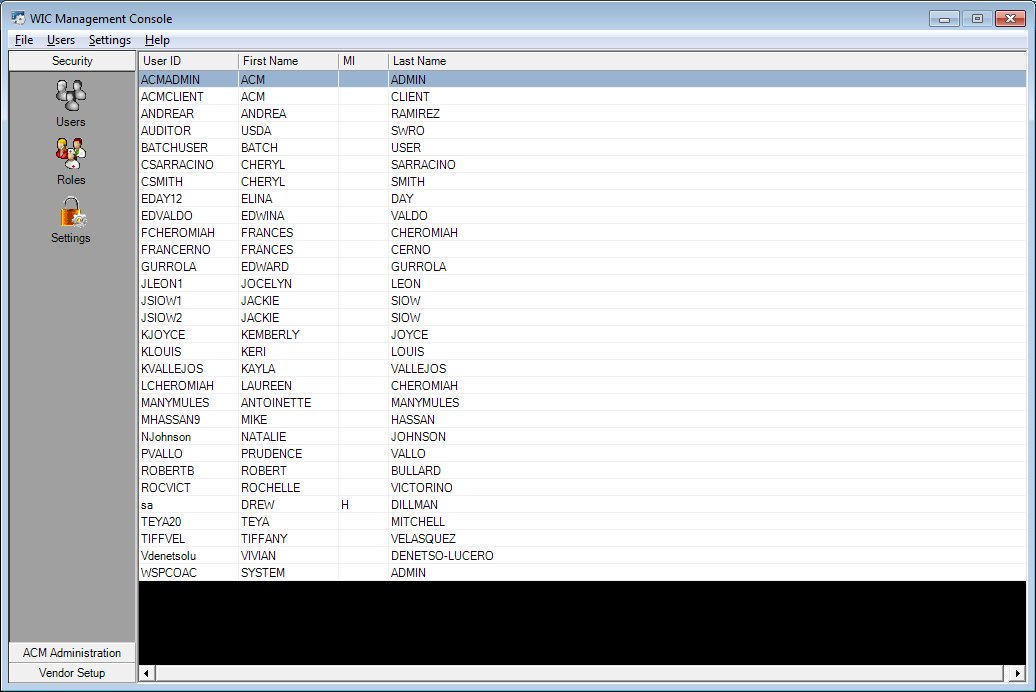
Contents Show
The WIC Management Console screen is used to manage users who access the application and their specific roles, to manage the machines or clinics that are capable performing data synchronization (remote machines or clinics), and to manage e-mail and fax configuration settings.
A menu bar is displayed at the top of the screen and a vertical menu is displayed along the left side of the screen. The menu bar provides access to functions that are available. Select a menu to display the available menu options, and then select a menu option to activate its functionality. The vertical menu provides access to frequently used functions, usually with a single-click. Click a vertical menu shortcut to activate its functionality.
For more information about the menu bar and the vertical menu, see the following topics:

WIC Management Console screen (Security (Users) mode)
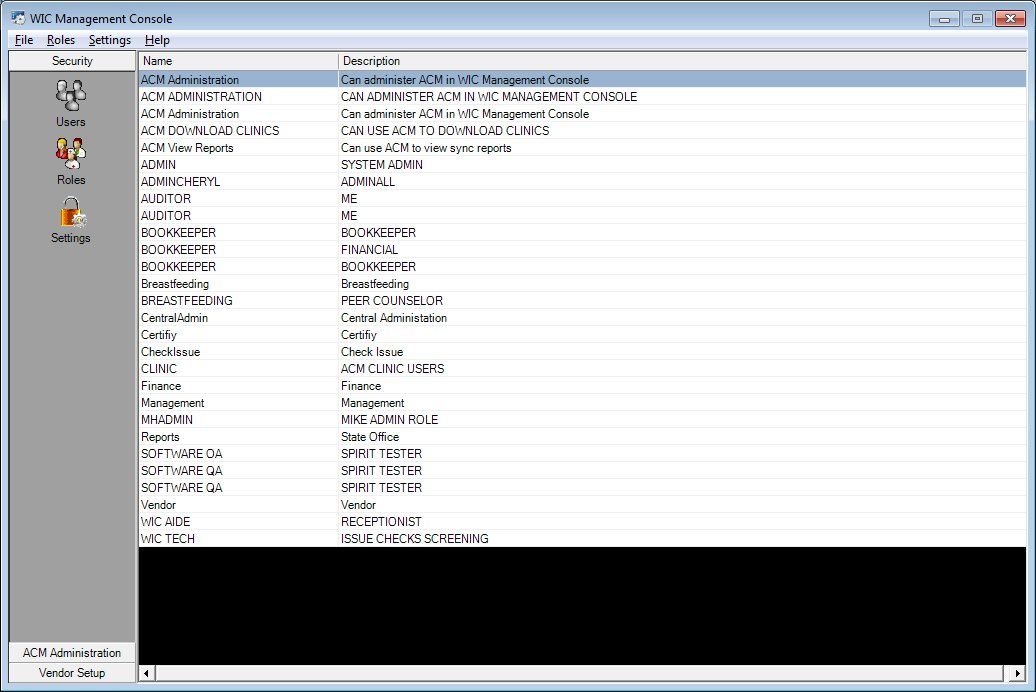
WIC Management Console screen (Security (Roles) mode)
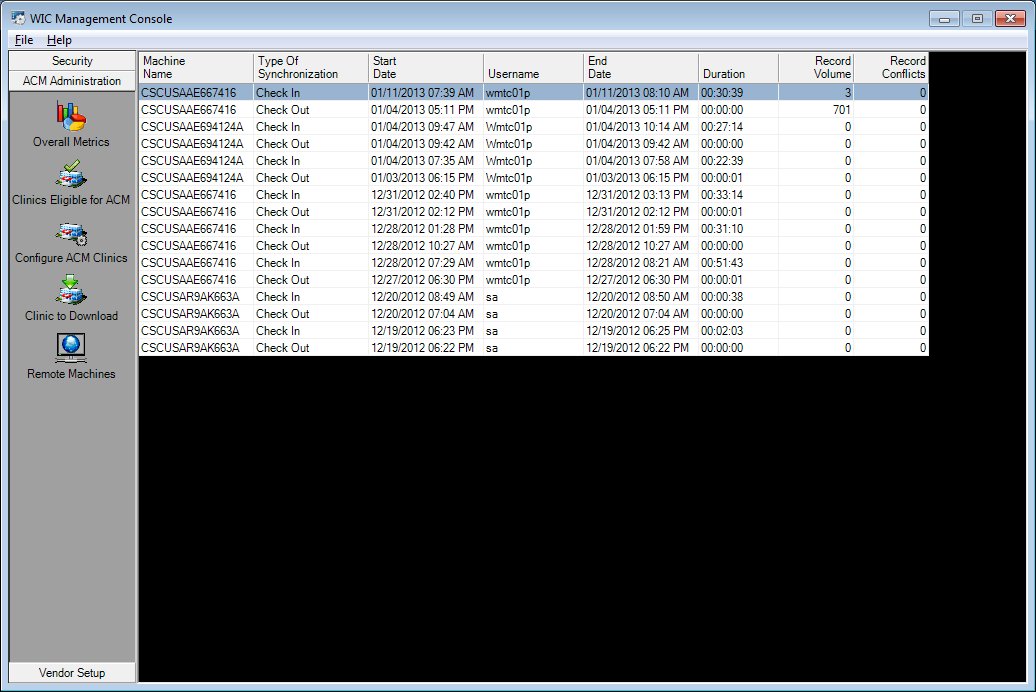
WIC Management Console screen (ACM Administration (Overall Metrics) mode)
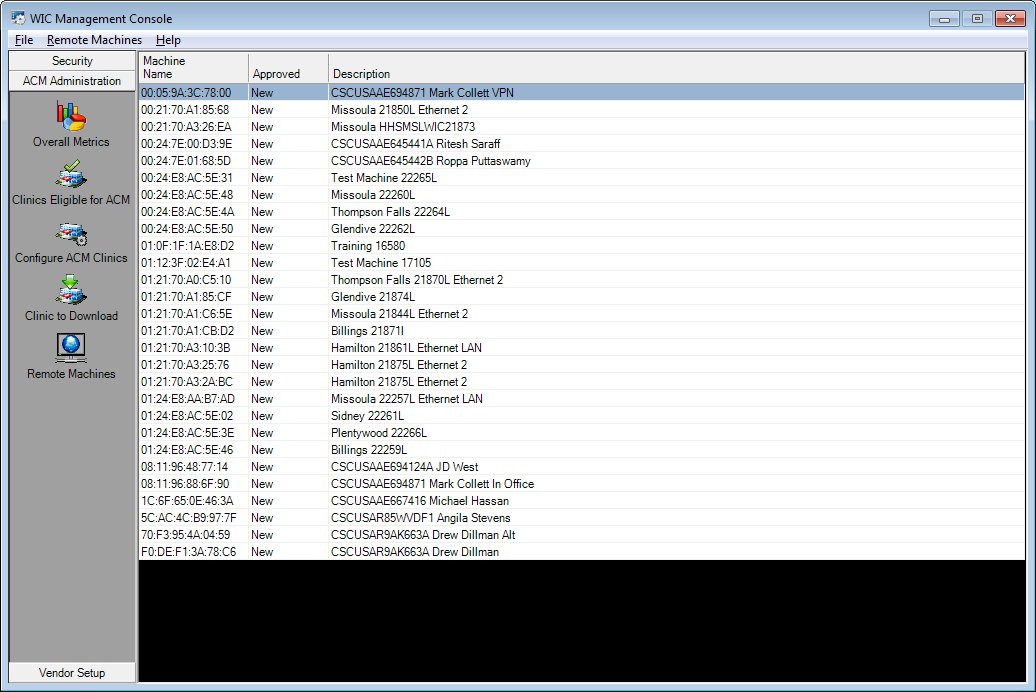
WIC Management Console screen (ACM Administration (Remote Machines) mode)
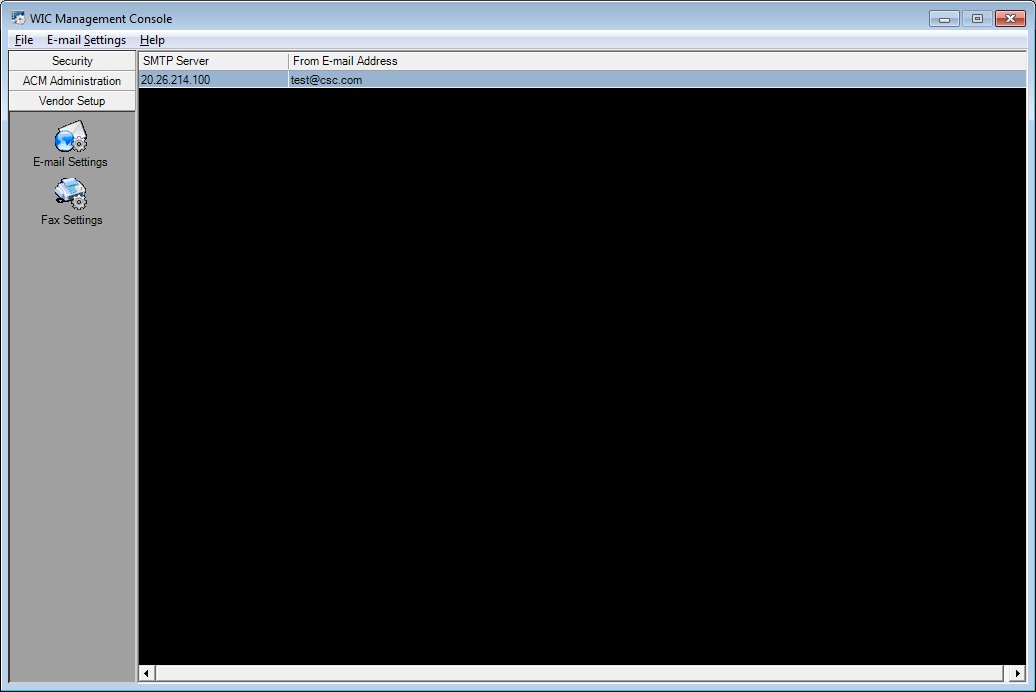
WIC Management Console screen (Vendor Setup (E-Mail) mode)
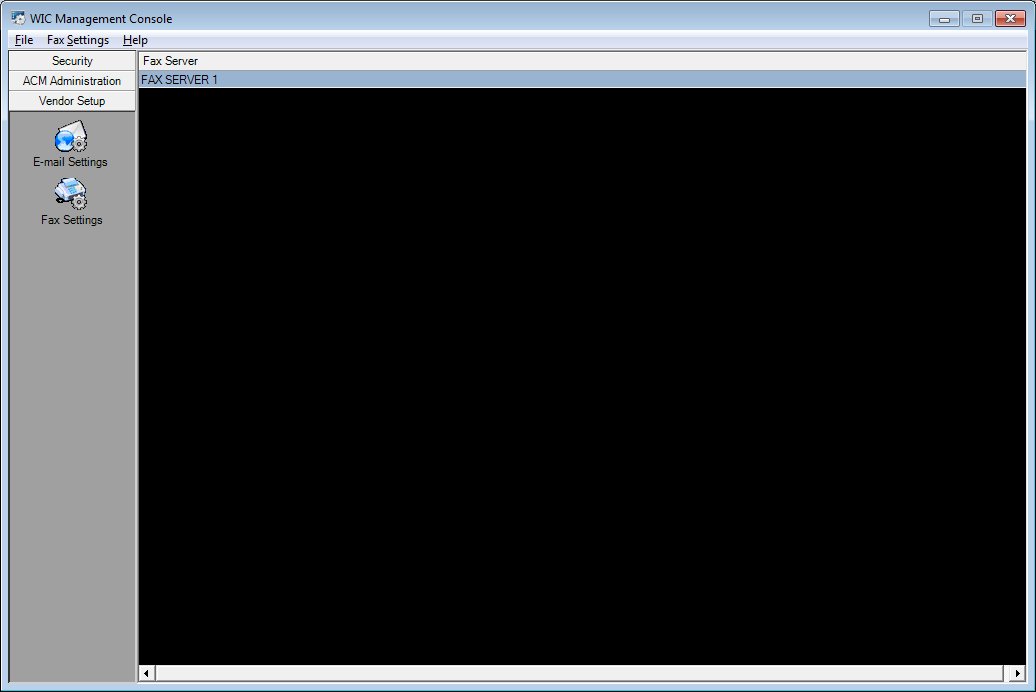
WIC Management Console screen (Vendor Setup (Fax) mode)
|
|
Interface InitializationUpon initial display of the screen, the following occurs:
|
Unless otherwise stated below, all controls on the WIC Management Console screen are visible and enabled when:
The screen is active.
If one or more special conditions exist that affect a control on the WIC Management Console screen, the condition(s) are documented for that specific control below.
View the WIC Management Console vertical menu.
A vertical menu is a navigation column on the left side of the screen. A vertical menu contains groups of shortcuts to and/or tasks that can be performed. Clicking a group on the vertical menu collapses the current group of shortcuts and expands the selected group of shortcuts.
For more information, see the Management Console vertical menu topic.
View the information in the WIC Management Console data grid.
This data grid displays records specific to the group and shortcut currently selected on the vertical menu. Double-click a record in the data grid to view and/or manage information for the selected record.
In Security (Users) mode, this data grid displays all users that currently have user accounts recorded. The records in the data grid are sorted in alphabetical order by User ID.
In Security (Roles) mode, the records in the data grid are sorted in alphabetical order by Name.
Information displayed in the data grid is read-only an cannot be changed. The data grid supports single selection only. Records in the data grid can be sorted by clicking on the column headings.
The data grid consists of the following control(s):
User ID column
This column displays the user ID for each record displayed within the data grid.
The title of the column is set to "User ID". The information displayed within the column is read-only.
The control is visible and enabled when:
The screen is displayed in Security (Users) mode.
First Name column
This column displays the first name of each person displayed within the data grid.
The title of the column is set to "First Name". The information displayed within the column is read-only.
The column header and data are left aligned.
The control is visible and enabled when:
The screen is displayed in Security (Users) mode.
MI column
This column displays the middle initial of each person displayed within the data grid.
The title of the column is set to "MI". The information displayed within the column is read-only.
The column header and data are left aligned.
The control is visible and enabled when:
The screen is displayed in Security (Users) mode.
Last Name column
This column displays the last name of each person displayed within the data grid.
The title of the column is set to "Last Name". The information displayed within the column is read-only.
The column header and data are left aligned.
The control is visible and enabled when:
The screen is displayed in Security (Users) mode.
Name column
This column displays the name for each record displayed within the data grid.
The title of the column is set to "Name". The information displayed within the column is read-only. The column header and the data within the column are left aligned.
The control is visible and enabled when:
The screen is displayed in Security (Roles) mode.
Description column
This column displays the description of each record displayed within the data grid.
The title of the column is set to "Description". The information displayed within the column is read-only. The column header and the data within the column are left aligned.
The control is visible and enabled when:
The screen is displayed in Security (Roles) mode.
The screen is displayed in ACM Administration (Remote Machines) mode.
Machine Name column
This column displays the name of the computer for each record displayed within the data grid.
The title of the column is set to "Machine Name". The information displayed within the column is read-only.
The control is visible and enabled when:
The screen is displayed in ACM Administration (Overall Metrics) mode.
The screen is displayed in ACM Administration (Remote Machines) mode.
Type of Synchronization column
This column displays the synchronization type (Check In or Check Out) for each record displayed within the data grid.
The title of the column is set to "Type of Synchronization". The information displayed within the column is read-only.
The control is visible and enabled when:
The screen is displayed in ACM Administration (Overall Metrics) mode.
Start Date column
This column displays the start date for each record displayed within the data grid.
The title of the column is set to "Start Date". The information displayed within the column is read-only.
The control is visible and enabled when:
The screen is displayed in ACM Administration (Overall Metrics) mode.
Username column
This column displays the identification of the user who performed the check out for each record displayed within the data grid.
The title of the column is set to "Username". The information displayed within the column is read-only.
The control is visible and enabled when:
The screen is displayed in ACM Administration (Overall Metrics) mode.
End Date column
This column displays the end date for each record displayed within the data grid.
The title of the column is set to "End Date". The information displayed within the column is read-only.
The control is visible and enabled when:
The screen is displayed in ACM Administration (Overall Metrics) mode.
Duration column
This column displays the check out duration for each record displayed within the data grid.
The title of the column is set to "Duration". The information displayed within the column is read-only.
The control is visible and enabled when:
The screen is displayed in ACM Administration (Overall Metrics) mode.
Record Volume column
This column displays the number of records that have been modified for each record displayed within the data grid.
The title of the column is set to "Record Volume". The information displayed within the column is read-only.
The control is visible and enabled when:
The screen is displayed in ACM Administration (Overall Metrics) mode.
Record Conflicts column
This column displays the number of record conflicts for each record displayed within the data grid.
The title of the column is set to "Record Conflicts". The information displayed within the column is read-only.
The control is visible and enabled when:
The screen is displayed in ACM Administration (Overall Metrics) mode.
Approved column
This column displays the approval status (Yes, No, or New) for each record displayed within the data grid.
The title of the column is set to "Approved". The information displayed within the column is read-only.
The control is visible and enabled when:
The screen is displayed in ACM Administration (Remote Machines) mode.
SMTP Server column
This column displays the SMTP Server IP address for each record displayed within the data grid.
The title of the column is set to "SMTP Server". The information displayed within the column is read-only.
The control is visible and enabled when:
The screen is displayed in Vendor Setup (E-Mail) mode.
From E-mail Address column
This column displays the e-mail from which the server sends each e-mail for each record displayed within the data grid.
The title of the column is set to "From E-mail Address". The information displayed within the column is read-only.
The control is visible and enabled when:
The screen is displayed in Vendor Setup (E-Mail) mode.
Fax Server column
This column displays the fax server for each record displayed within the data grid.
The title of the column is set to "Fax Server". The information displayed within the column is read-only.
The control is visible and enabled when:
The screen is displayed in Vendor Setup (Fax) mode.
If data can be validated and saved on the screen, the following processes occur when the screen is processed:
A process to check for required controls as identified in the Data Map below is performed.
A process to check for valid entries as identified individually for each applicable control in Screen Elements above is performed.
A process to check for edits and cross edits as identified for each applicable control in Screen Elements above is performed.
If any checks or processes fail, a standard error message displays.
If no data can be validated and saved on the screen:
No cross edits are performed.
All values are considered legitimate.
No data is written to the database.
The Data Map defines the values saved for all controls on the screen. If available, any additional notes or comments are displayed in the Notes column.
|
Control Label |
Control Type |
Table. Column |
Notes |
|
WIC Management Console |
data grid label |
· |
· |
|
User ID |
data grid column |
UserProfile. UserID |
Only visible in Security (Users) mode. |
|
First Name |
data grid column |
UserProfile. FirstName |
Only visible in Security (Users) mode. |
|
MI |
data grid column |
UserProfile. MiddleInitial |
Only visible in Security (Users) mode. |
|
Last Name |
data grid column |
UserProfile. LastName |
Only visible in Security (Users) mode. |
|
Name |
data grid column |
Role. Name |
Only visible in Security (Roles) mode. |
|
Description |
data grid column |
Role. Description RemoteMachine. Description |
Role.Description is only visible in Security (Roles) mode. RemoteMachine.Description is only visible in ACM Administration (Remote Machines) mode. |
|
Machine Name |
data grid column |
Checkout. MachineName RemoteMachine. MachineID |
Checkout.MachineName is only visible in ACM Administration (Overall Metrics) mode. RemoteMachine.MachineID is only visible in ACM Administration (Remote Machines) mode. |
|
Type of Synchronization |
data grid column |
Calculated; possible values "Check In" or "Check Out" |
Only visible in ACM Administration (Overall Metrics) mode and ACM Administration (Remote Machines) mode. |
|
Start Date |
data grid column |
Checkout. CheckoutStart |
Only visible in ACM Administration (Overall Metrics) mode. |
|
Username |
data grid column |
Checkout. CheckoutByAppUserID |
Only visible in ACM Administration (Overall Metrics) mode. |
|
End Date |
data grid column |
Checkout. CheckInFinish |
Only visible in ACM Administration (Overall Metrics) mode. |
|
Duration |
data grid column |
Calculated; time span between Checkout.CheckInFinish and Checkout.CheckInStart |
Only visible in ACM Administration (Overall Metrics) mode. |
|
Record Volume |
data grid column |
SUM(TotalChanges) AS TotalChanges FROM dbo.SynchronizationStatistics |
Only visible in ACM Administration (Overall Metrics) mode. |
|
Record Conflicts |
data grid column |
SELECT COUNT(*) AS RecordConflicts FROM dbo.SynchronizationConflicts |
Only visible in ACM Administration (Overall Metrics) mode. |
|
Approved |
data grid column |
RemoteMachine. Approved |
Only visible in ACM Administration (Remote Machines) mode. |
|
SMTP Server |
data grid column |
CommRequest. ServerName |
Only visible in Vendor Setup (E-Mail) mode. |
|
From E-mail Address |
data grid column |
CommRequest. FromEmailAddress |
Only visible in Vendor Setup (E-Mail) mode. |
|
Fax Server |
data grid column |
CommRequest. ServerName |
Only visible in Vendor Setup (Fax) mode. |
~ Denotes a required control (if applicable). The process that checks for required controls does not occur on screens displayed in read-only or Details mode.
+ Denotes data written to the database when screen processing occurs (if applicable). The process that writes data to the database does not occur on screens displayed in read-only or Details mode.
|
Software Version: 2.40.00